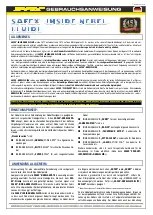
41
Causes of troubles and troubleshooting
Direction and height of
needle
Needle
Ascending level of needle
bar
Height of needle
Gap between needle and
hook
Threading method
Needle
Direction and height of
needle
Upper thread tension
Lower thread tension
Working capacity of take-up
lever spring
Direction and height of
needle
Needle
Threading
Ascending level of needle
bar
Height of needle bar
Gap between needle and
hook
Racing-proof spring of
bobbin case
Take-up lever spring
Needle breaks
Thread breaks
Stitch skips
1
2
3
Needle is inserted into wrong
direction.
Needle is bent.
Bad timing of feed dog.
Bad timing of needle and hook.
Bad timing of needle and hook.
Bad timing of needle and hook.
Wrong threading.
Bent needle or broken needle tip.
Needle inserted in the wrong
position.
Too tight upper thread tension.
Too tight lower thread tension.
Loose upper thread.
Needle inserted in the wrong
position.
Bent needle or broken needle tip.
Thread passing at wrong position.
Wrong timing of needle and hook.
Wrong timing of needle and hook.
Wrong timing of needle and hook.
Remaining length of upper thread
is short .
Due to bobbin racing during
trimming, lower thread dropping
from bobbin case becomes too
short to go up.
Unable to lift lower thread due to
weak take-up lever spring.
Reinsert the needle correctly.
Replace the needle.
Adjust the timing of feed dog.
Adjust the timing of needle and
hook.
Adjust the timing of needle and
hook.
Adjust the timing of needle and
hook.
Thread the needle correctly.
Replace the needle.
Insert the needle correctly.
Reduce tension of upper thread.
Reduce tension of lower thread.
Adjust take-up lever spring.
Reinsert the needle in the right
direction.
Replace the needle.
Replace the needle.
Adjust the timing of needle and
hook.
Adjust the timing of needle and
hook.
Adjust the timing of needle and
hook.
Adjust the thread adjusting
device.
Replace the racing protection
spring.
Adjust the working capacity of
take-up lever spring.
No
Symptom
Checkpoints
Root cause
Corrective action
Summary of Contents for KM-1070 SERIES
Page 2: ......


































